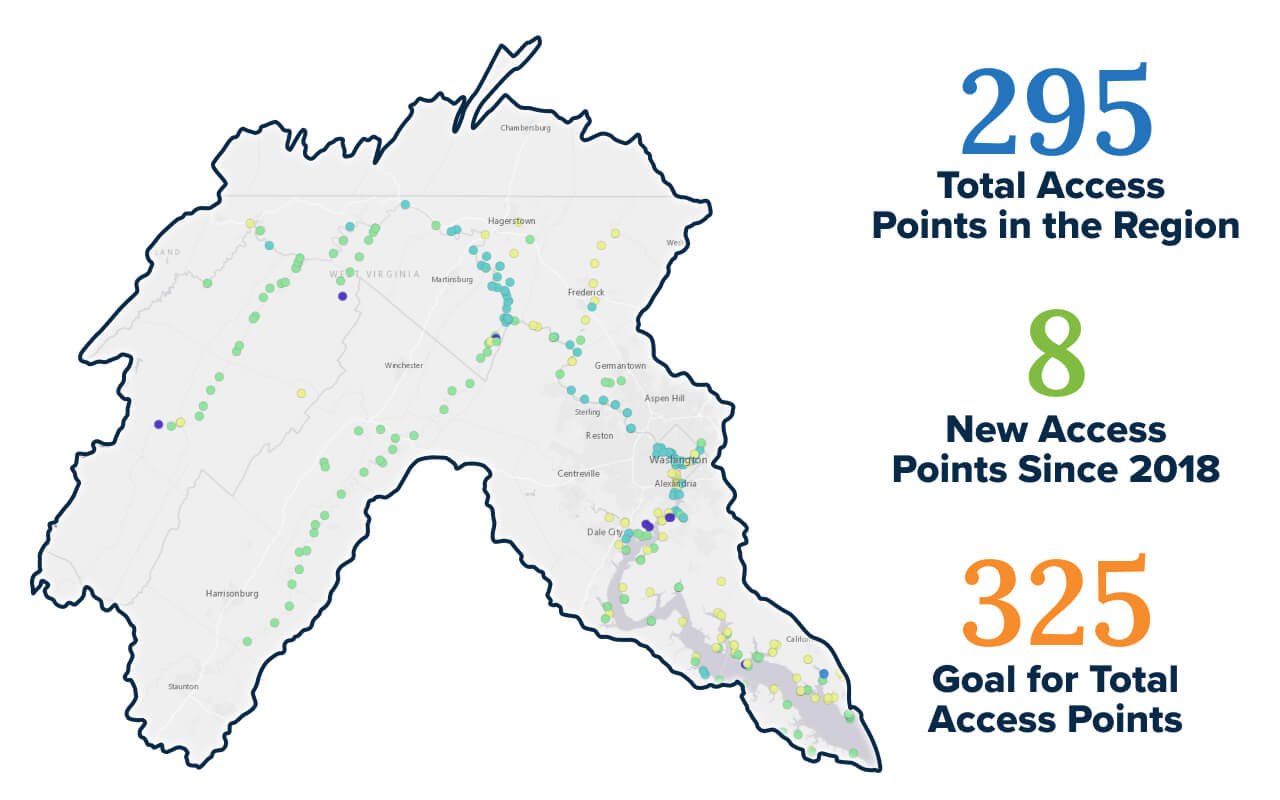2023 Potomac River Report Card
#PotomacReportCard
People
The Potomac River and its communities are inexorably tied together in both their health and longevity. A watershed capable of supporting healthy streams and diverse habitats will likewise ensure the highest levels of ecological benefits to the people who live there. The Potomac River region is home to a diverse array of people, including 5 million residents in the greater Washington, DC metro area who receive their daily drinking water from the river.
By assessing watershed benefits such as public access and river recreation, we can gain a better understanding of the complex relationship that our local environment has with the people who call it home. Through kayaking, hiking, picnicking, fishing, and other outdoor recreational activities, we hope to help our community build a strong and long-lasting relationship with the Potomac and cultivate river stewards from all corners of the watershed.


Public Access Points
Increased river access reflects improving water conditions and also demonstrates the Potomac’s value to the health and well-being of our community. The EPA has set a goal in its Chesapeake Bay Watershed Agreement of adding 300 new public access points by 2025. Expanding upon this goal, Potomac Conservancy has set a goal of achieving 325 public access points in the same timeframe. As of December 2020, the Potomac River watershed is meeting 90 percent of our public access point goal. A total of six access points were added in the Potomac region in 2020 alone, a dramatic increase from just one in 2019.
Public Access Points

Source: Chesapeake Progress courtesy of the US EPA Chesapeake Bay Program


Sport Fishing Licenses
Recreational fishing along the Potomac River has been enjoyed by the region's inhabitants for thousands of years. Native peoples found nourishment in the river’s abundant fish populations, developing efficient methods to capture fish. Soft, muddy river bottoms supported fishing traps built from sticks and tall reed grasses, while stony bottomed river sections featured traps constructed from river rocks. Some of these V-shaped stony structures, known as weirs, can still be seen today.
With an ideal mix of geography and different fish species, the sale of sport fishing licenses in the region is an important metric to gauge overall recreation along the river year after year. Fishing licenses are bought at the state level or from the Potomac River Fisheries Commission (PRFC) for tidal stretches of the river. For the purposes of this metric only licenses sold from the District of Columbia and the PRFC were considered.
License numbers along the tidal Potomac began to decline in 2012, plateauing at a low of 1,600 annual licenses purchased from PRFC. However, due to robust fishing education and outreach efforts by the District of Columbia, license numbers in the nation’s capital have steadily increased with 7,814 sold in 2020 alone. It’s important to note that due to individual state procedures for license sales these numbers are an under-reporting of the total number of anglers in the Potomac region and miss a portion of headwater anglers.
Sport Fishing Licenses
Goal = 11,721 annual licenses sold
Started using DC licenses sale data in 2019
Source: Potomac River Fisheries Comission and
District Department of Energy and Environment (DOEE)


Outdoor Recreation
Outdoor recreation continues to be on the rise throughout the nation, and the Potomac River region is no different. According to the Outdoor Industry Association, at least 53 percent of people ages six and older participated in at least one outdoor activity in 2020. This trend was reflected in states adjacent to the Potomac River (WV, VA, MD, DC) with an average of 56 percent of state residents participating in an outdoor activity.
With increased recreation comes increased spending as well, which can be a boon to local towns and communities. Outdoor recreation brought in a total of $1.2 billion in local tax revenue to the Potomac River watershed and supported 191,723 jobs throughout the region in 2020. Stronger community connection with the outdoors can drive public support for resources that protect, restore, and conserve our natural world.
Outdoor Recreation (participation percentage)
National Average: 62%
Source: Outdoor Industry Association


Park Visitation
Park visitation skyrocketed in most state and national parks throughout the region, with average park visitation increasing by 18 percent from 2019 to 2020 as area residents sought safe and healthy ways to exercise, recreate, and socialize during the COVID-19 pandemic. Data from 2021, which falls outside the scope of this report, confirms this as preliminary visitation numbers show a subtle decrease into 2021 as virtual work decreased and more watershed residents moved back to an in-person work schedule. It’s our hope that the increase in outdoor recreation and park visitation seen in 2020 continues and seeds new Potomac River stewards from across the watershed. There is no river restoration target for Potomac River park visitation.
National and State Park Visitors in the Potomac Watershed
Park Visitors in the Potomac Watershed (Millions)
Sources: National Park Service, Maryland Park Service, Virginia State Parks, West Virginia State Parks and Forests

Resources and Methodology
Statistics for Potomac public access points were provided by Chesapeake Progress, which compiles yearly statistics for states and watersheds across the Chesapeake Bay region. Recreational sport fishing license numbers were obtained from the Potomac River Fisheries Commission (PRFC) and the District Department of Energy and Environment (DOEE). License data may underreport the total number of Potomac licenses as licenses sold in VA, MD, and WV aren’t correlated to a specific watershed. Park visitation data was provided by state parks departments as well as the U.S. National Park Service. All outdoor recreation data was provided via the Outdoor Industry Association and their annual state-focused reports.
Data for the People indicator was obtained via the PRFC, DOEE, the Outdoor Industry Association, the Chesapeake Bay Program, Maryland DNR, Virginia Department of Conservation and Recreation, West Virginia DNR, and the U.S. National Park Service.






 Back to the River
Back to the River